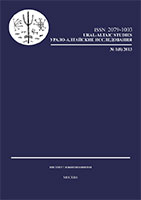
We kindly inform you that, as long as the subject affiliation of our 300.000+ articles is in progress, you might get unsufficient or no results on your third level or second level search. In this case, please broaden your search criteria.

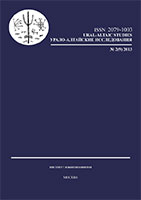
Constructions with serial verbs (verb pairs, pair-verbs, paired verbs) in the Finno-Ugric languages of the Volga-Kama region (in comparison with ones in the Samoyedic languages) are dealt with in the article. The author proves the point of view about independent and spontaneous development of serial verbs in the Uralic languages, also favoured by contacts with the Turkic languages.
More...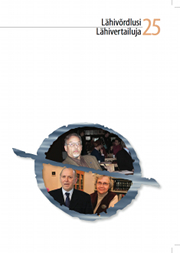
The article described the use of the conditional mood in written exam texts of adult second language learners of Estonian at B1 and B2 level. Be study on which the article is based is part of a larger study, the goal of which is to develop linguistic descriptions to accompany the functional descriptions of B1 and B2 level given in the Common European Framework of Reference for Languages (CEFR 2007). This is to be achieved by identifying the linguistic categories typically used at these levels, describing their frequency of use, analyzing their complexity and accuracy (Housen et al. 2012), determining the connections between the categories and various discourse functions, and specifying descriptors that serve to distinguish between the two levels.As the conditional mood is used far more at B2 level than at B1 level (Kitsnik 2014), it is one of the categories distinguishing B2 from B1 which requires more detailed study. Be results of the study discussed in the article show that at both B1 and B2 level, only the personal voice present tense forms of the conditional mood are used. At B1 level, the conditional is used with eight different verbs,most frequently tahtma ‘to want’ and saama ‘be able to’. At B2 level, the conditional is used with 23 different verbs, most often with tahtma ‘to want’, olema ‘tobe’, võima ‘to be able to’, pidama ‘must’, soovima ‘to wish, desire’, and soovitama‘to recommend’.At B2 level, the conditional is used in more morphological forms than those found at B1 level (the first and third person singular), and it also appears in a range of other constructions (with an object, with a predicate, and in both the main and subordinate clauses of complex sentences) in addition to the B1-level construction of “verb in conditional + infinitive”. As regards discourse functions, the conditional is used at both B1 and B2 level primarily to express politeness. Linguistic accuracy increases at B2 level in the constructions which are used also at B1 level.
More...
The aim of this paper is to explore the relationship of Finno-Ugric studies and language teaching: What can the Finno-Ugric inheritance or relatedness mean in the practice of teaching and learning Finno-Ugric languages as a second or foreign language? Beyond the background knowledge which is typically incorporated in the academic teaching of the Finno-Ugric languages,questions of the history and relatedness of these languages may surface in connection with two aspects. First, the teaching of the rich and complex morphology and, in particular, morphophonology might profit from excursions into the (pre)history of the language. Second, Finno-Ugric languages are often “othered”,seen as “something different” and contrasted with major (Indo-)European languages. This fact, although it may play a crucial role for the recruitment and motivation of the students, has – like aspects of identity in general – often been ignored in the study of language teaching.
More...
The article examines Estonian given names in the year 1900. The material comes from all 124 Lutheran congregations on the territory of present-day Estonia. In addition to the names themselves, other aspects of working with documents from this time are discussed (Russian language, old orthography in names). The most popular female names were Marie, Alide, and Hilda, while the most popular male names were August, Johannes, and Aleksander. Although the list of names had changed in the previous few decades, there were still examples of borrowed names belonging to the previous naming tradition (e.g. Liisa and Jaan, especially in western regions). In female names, the emerging trend of Estonian-origin names can be observed (e.g. Salme, Linda, Helmi, more in the east as well as in Viljandimaa). There are examples of names which were the most popular in one district (e.g. Hilda in Tartu or Elfriede in Tallinn) but were almost unknown in more conservative areas. Another new trend was the use of double first names, which also grew in popularity toward the end of the 19th century. As is typical of naming trends, this innovation was primarily seen in female names. It was most prominent in Tallinn (over 70% of girls’ names), Virumaa and the Tartu area; in the west, there were still congregations where all children received single names. As in other countries, factors influencing name usage in Estonia include industrial development, railroad construction, the growth of cities, increased mobility, the rise in the level of education, and the people’s increased exposure to literature; the activity of the nationalist movement also played a role. These wide-ranging changes in people’s way of life led them to adopt a more liberal attitude toward name usage. Despite Estonia’s small size, there are quite substantial regional differences in the changes in name usage. The country can broadly be divided into two regions: the conservative West (Harjumaa, Läänemaa, the islands, Pärnumaa, Viljandimaa, Järvamaa) and the innovative East (Virumaa, Tartumaa, Võrumaa). More innovative name usage was also observed in cities (in this study Tallinn, Tartu, and Narva).
More...
The article deals with the various forms and functions of polar questions in written Estonian, as well as the relationships between form, function and text type. The analysis is based on material from 17th and 18th-century religious and didactic texts, modern fiction and journalistic texts, internet comment sections and Instant Messaging dialogues. 100 questions from each text type were used in the study. We divide the means of forming polar questions into primary (question markers and word order) and secondary (question-marking conjunctions and epistemic modal particles) means, as well as declarative sentences with question marks. The main ways of forming polar questions are sentence-initial question particles (chiefly kas) and declarative sentences or questions featuring only secondary question markers. Each of these groups accounts for 27% of all questions. Sentence-final markers are common only in online dialogues, and inversion appears frequently only in old religious texts. Polar question markers and their usage differ between old and modern texts. Verbal markers have moved from the beginning of the sentence to the end, and the proportion of questions formed by secondary question markers has increased. The primary function of polar questions in all text types except for old religious literature is to ask for confirmation of one’s understanding (questions expressing assumptions or doubts); this function accounts for 56–75% of all questions. The proportion of information-seeking questions is 31–32% in fiction and journalistic texts and between 0–14% in other text types. Moreover, all text types featured examples of directives and rhetorical questions, and old religious texts featured “testing” questions (where the questioner knows the answer and is testing the conversation partner’s knowledge). In modern texts, requests for information are expressed primarily by sentence initial particles and word order. Information-seeking questions did not appear in older texts. Questions expressing doubt were formed in all printed texts by markers similar to those used to request for information; in internet texts, the usage of different markers was more variable. Questions expressing assumptions are in modern texts expressed primarily by declarative sentences and secondary markers, as well as sentence-final question markers in internet texts. In old written texts, such questions are formed by sentence-initial particles, which are often accompanied by secondary markers. Overall, secondary markers are closely associated with questions expressing assumptions, but are hardly ever found in information-seeking questions. The analysis reveals that the primary function of polar questions and the relationships between form and function do not depend on the time period, text type, or the reality/fictionality of the interaction. The preferences for particular means of question formation were not affected by prescriptive norms or language contact.
More...
The development of the lexicon and conceptual system of Estonian has been influenced by the translation of Bible into Estonian. In order to achieve a more precise translation, new words were created either by means of borrowings or derivation using extant word stems. One of the central concepts in Christianity is agape (love), which was translated in early Estonian texts mostly by the word ‘arm’, which was a word with a rather broad meaning. During the Bible translation in the beginning of the 18th century, a new term ‘armastus’ was derived from the same-stem verb ‘armastama’, as an exact counterpart for Greek agape. In the later development of Estonian, the meaning of this term expanded. In the article, the development of Estonian counterparts of agape and the closely related concepts charis and eleos are examined with the comparisons of Latin and German terms, which were languages also used in Estonia during the missionary work and Bible translation.
More...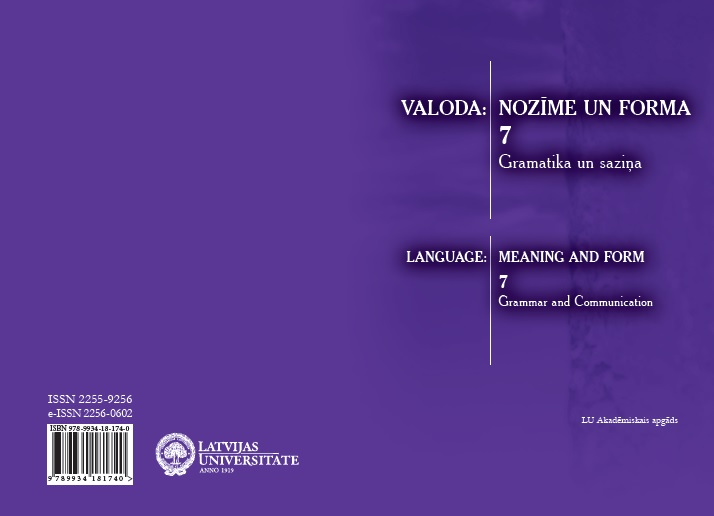
In Baltic and Finnic languages, the subject and object cases show a similar variation, with nominative or partitive genitive subjects and accusative or partitive genitive objects. The similarities are stronger between Finnic (here represented by Finnish) and Lithuanian, whereas in Latvian the use of the partitive genitive is decreasing. This applies both to affirmative and negated sentences. In this paper, the main attention is paid to the Latvian object cases with negation. Examples from literature, both original and translated from Finnish, were presented to a small group of native Latvian speakers living in Finland, with the expectation that the strong similarities between Latvian genitive and Finnish partitive use with negation might affect the choices. However, that did not seem to be the case. The genitive appears to be specialized to express emphatic negation. Genitives of subject in negated existential sentences were compared in translations of Finnish fiction. Partitives are the rule in negated existential sentences in Finnish, and partitive genitives almost to the same extent in Lithuanian. Again, in Latvian the use of the genitive in this function is decreasing. As a rule, it applies to the existential nebūt ʽnot to beʼ, although spoken language tends towards the nominative.
More...
The goal of this paper is to analyze what the equivalents of the Latvian verb prefix ie- in Estonian are. In Latvian, verb prefixes are used to derive verbs by changing imperfective verbs into perfective, but also to vary the lexical meaning of the verb. Estonian lacks verb prefixes and perfectivity/imperfectivity is expressed by direct object (nominative/genitive vs. partitive case), by adverbs, but also taking into consideration the whole sentence. Since there are 11 verb prefixes in Latvian, it would be too capacious a task to analyze all of them at a time, therefore for this paper one of the prefixes is chosen – the prefix ie-. The analysis is based on prefix function grouping by Emīlija Soida (2009) and examples are taken from four Latvian literary works and their translations into Estonian.
More...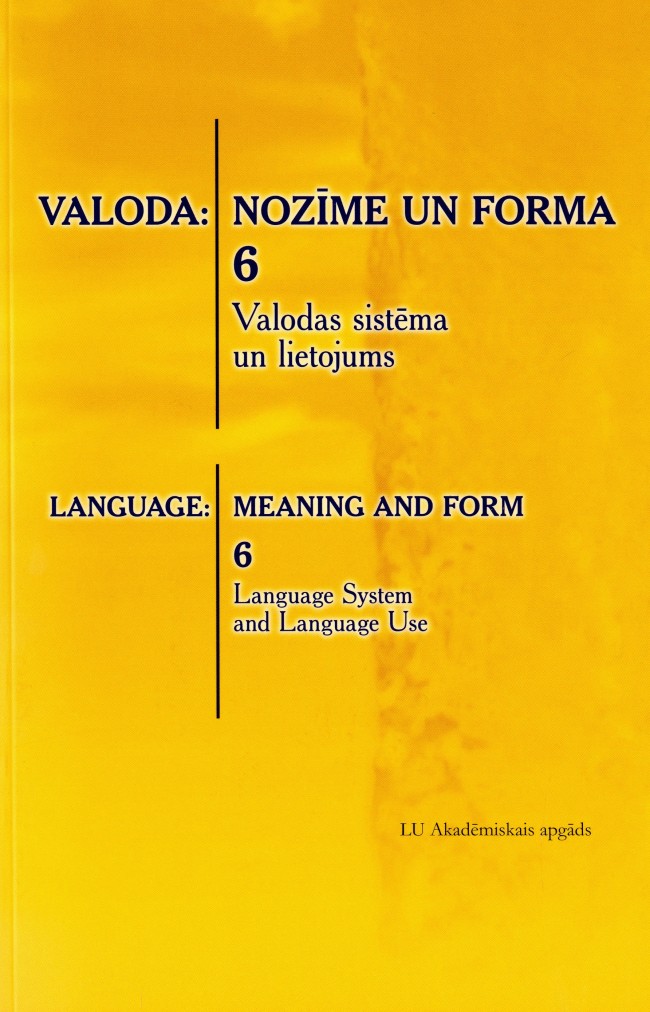
Lutsi Estonian is a variety of South Estonian historically spoken in the pre-World War II rural parishes of Pilda, Nirza, Brigi, and Mērdzene near the city of Ludza in Latgale (eastern Latvia). Lutsi developed independently from other South Estonian dialects for at least several centuries and as a result differs in several respects from the South Estonian presently spoken in the Võru and Setu regions of Estonia and adjacent areas in Russia. Since early 2013, I have been documenting the remaining language and culture knowledge among present-day Lutsi descendants and revisiting the villages documented by Oskar Kallas in 1894 as having Estonian (Lutsi) speaking inhabitants. The goal of this research is to write a Lutsi language primer with which Lutsi descendants as well as other interested individuals can reacquaint themselves with one of the historic languages of Latgale. This article presents the Lutsi practical orthography I have designed. I begin by introducing the Lutsi people, their language, and the history of its documentation. In discussing the Lutsi language I address the particular issues involved in writing Lutsi and present Livonian as a a model for writing a Finnic language for a primarily Latvian-speaking population. I then present the current form of the Lutsi practical orthography at the end of this article.
More...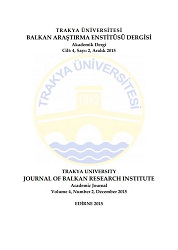
Turkish and Hungarian people relationship is based on a long and traditional friendship. Compact researches about Hungarian language and historybegan in 19th century led to birth of Turan Tacitc and Science of Turcology. Studies of these two disciplines intervened to strength cultural bridges. Turkey and Hungary, who fought as allies in World War I and established their national states after the fall of the empire, have established the semi-official relations since 1920s and official relations on December 18, 1923 with the Friendship Treaty. During Atatürk’s era, relations between the two countries was quite busy and friendly. Despite taking place in opposing penetrating forces during the bipolar system aka Cold War, two countries maintained their relations based on traditional friendship. In this study we tried to find the two centuries relations in the political, economic and cultural after being classified as the ancient friendship and Turcology/Hungarology attempted to examine how it has continued over the platforms.
More...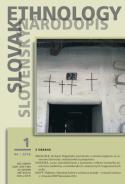
On the basis of language biographies of multilingual three-generation families in Bratislava, the paper explores the communication strategies on the use of Hungarian in public. The research was conducted in the form of narrative interviews with members of five families. A total of 23 interviews were conducted. The use of a language in public is complementary influenced by language legislation, the social and political situation and individual experience. The obtained material is analysed at two levels: at the level of experience (reality of the subject) and narration (reality of the text). At the level of experience, the following strategies of avoiding conflicts have arisen from the described situations: 1) silence; 2) muting of the voice; 3) switching into Slovak; 4) switching into a “neutral” language (German); 5) responding in Slovak; and 6) preparation of children for negative attitudes. At the level of narration, the negative experience is refined using the following tools: 1) degrading the legitimacy of the attacker; 2) highlighting the “good deeds” of the members of the majority; 3) lapse of time; and 4) declared forgetting.
More...
The article concentrates on the image and reception of Slovak literature in specialised Hungarian-language texts from the period of Austro-Hungarian Compromise. In the history of Slovak-Hungarian relations, this period was one of the most complicated: the middle classes were being speedily assimilated and the Slovak culture was under intense pressure of the state and Hungarian culture. The first comprehensive publication on Slovak literature in this period was written by Imre Gáspár as early as 1879, but it remained without much feedback. Subsequent articles and encyclopaedic entries were penned by Slovak authors who either worked in Budapest as civil servants (Samo Czambel, Adolf Pechány) or were based directly in Martin, Slovakia (Jozef Škultéty). Škultéty was invited to write on Slovak literature by the Budapest-based professor Oszkár Asbóth who also authored a journal article on Svetozár Hurban Vajanský. Despite differences in authors’ social and cultural backgrounds, the narrative texts share several similarities: in the introduction, they provide a general overview of the history of the Slovak language and literature and then deal with outer-literary aspects in the works of a few authors and looked for similarities. The works of Ján Hollý and Andrej Sládkovič were held in especially high esteem.
More...
This article explores the historical development of the meanings of two key words in 16th–19th century literary Estonian – raamat ‘book’ and kiri ‘letter, message, etc.’ Literary Estonian emerged in the first half of the 16th century, following the Reformation, with the translation of religious literature from German. Even at that time, the Estonian words raamat and kiri were used with distinct meanings. This article examines the evolution of their usage, drawing primarily on Corpus of Old Written Estonian and dictionaries. At the same time, it seeks to answer how and why, unlike in Finnish, the word raamat in Estonian came to refer to various types of texts, while kiri retained meanings that diverged from its Finnish counterpart, kirja ‘book’. In old written Estonian, both raamat and kiri referred to written documents. Over time, the word raamat became associated with longer printed or handwritten texts, while kiri referred to shorter texts intended for a specific recipient and purpose. Both words were used to denote the Bible and its parts. The usage of these words by Baltic German religious authors was influenced by the example of German words, such as Buch, Schrift, and Brief. However, there were also several semantic developments that occurred independently of German influence. With the diversification of Estonian written culture, new types of books, documents, letters, and other written texts have continued to be introduced over the centuries. Already by the late 19th century, compound words had been created to describe many of these. Later, as a result of deliberate language planning, further adjustments were made to both the meanings and forms of these words, leading to the creation of new terms for emerging types of books and written materials.
More...
This article explores the development of written Estonian during the early national awakening period, with a focus on the mid-19th century, as reflected in literary translations. The language reform process involved a transition from the old orthography to a new one, reducing dialectal differences, and enriching the vocabulary. Translated texts played a central role in this process. By broadening readers’ worldview with new concepts and ideas, and introducing language innovations in an appealing and engaging context, translations from the early national awakening period significantly contributed to the evolution of written Estonian. The article highlights examples from the works of translators who are now largely forgotten, such as Berend Gildenmann, Heinrich Nieländer, and Aleksander Umblia, alongside texts by key figures of the early Estonian national awakening, including Johann Voldemar Jannsen, Friedrich Reinhold Kreutzwald, and Friedrich Nikolai Russow. During the mid-19th century, the majority of Estonian-language literature comprised translations from German folk literature, adapted to suit the needs and knowledge levels of Estonian-speaking audiences. Translators often added explanations, introduced new words, expanded the existing vocabulary, and included notes that provided cultural and geographical context. Faithfulness to the original source text was not a priority; texts could be abridged, expanded, or annotated as needed. Thus, Estonian translations of popular books, such as Kreutzwald’s Reinowadder Rebbane (1850) and Kilplaste imewärklikud, wäga kentsakad, maa-ilmas kuulmata ja tännini veel üleskirjutamata jutud ja teud (1857), heavily adapted European literary heritage. These and other literary translations helped cultivate reading habits among the Estonian people, establish a book market, and lay the foundation for the emerging tradition of original Estonian literature as a cultural and communal phenomenon. The article also examines the historical context of the 19th-century standardization of written Estonian and its links to broader social and cultural changes, such as ideological disagreements between Baltic German and Estonian intellectuals and the bilingualism of educated Estonians. It discusses the attitudes of translators towards the language reform as well as the debates and perceptions surrounding translation as a cultural process.
More...
The aim of this paper is to contrast Estonian and Finnish deictic motion verbs (minema/mennä, tulema/tulla, viima/viedä, tooma/tuoda) with descriptions of the same motion situations in Czech, which does not have similar pairs of deictic motion verbs. The paper first describes Estonian and Finnish deictic motion verbs according to the literature and provides a short overview of motion verbs in Czech. The analysis is based on examples selected from two literary texts, one Estonian and one Finnish, and their translations. The comparison concentrates on different means of anchoring the direction of motion, that is, which part of the motion scene is selected as the landmark for translational motion. The paper shows that though Czech verb prefixes can in effect anchor the direction of motion to the speaker or to a location known to the speaker and addressee, the function of these prefixes is not directly comparable with the pairs of deictic motion verbs in Finnish and Estonian.
More...
Mutual intelligibility of Baltic Finnic languages can be measured and observed in multiple ways. This article describes the development of a new kind of language test designed for informants whose mother tongue is Finnish or Estonian. The participating Finns’ language proficiency level in Estonian was 0, A or B, and Estonians’ level in Finnish was 0, A or B. Compared to previous test types, ways to measure mutual intelligibility, and measuring differences between cognates this test offers new features. The process of test word selection, test design, and scoring method are described phase by phase. The selection of cognates was conducted with meticulous care, as the test aimed to provide diverse data for analysis. One of the most important purposes of the test was to observe and analyse how these two groups of people understood cognates from each other’s language in different contexts. First, the cognates were translated one at a time, then as a part of sentences, and ultimately as a part of short text. Additionally, informants translated Vepsian and Livonian languages. Another objective in developing this test was to collect data for analysing whether Finns’ language skills in Estonian aided their understanding of Livonian and whether Estonians’ language skills in Finnish helped them to understand Vepsian. Hence, the informants not only translated cognates shared by all these languages but also those with specific etymological connections. For instance, they considered cognates like ‘parta’ and ‘bard’ (both meaning ‘beard’) – which have a common etymology only in Finnish and Vepsian – as well as ‘habe’ and ‘abbõnd’ (also meaning ‘beard’) – which share a common etymology exclusively between Estonian and Livonian. Furthermore, this type of test provides an opportunity to analyse how symmetric or asymmetric the level of understanding between Finnish and Estonian is. Therefore, the cognates in the test include morphologically rich word forms. The piloting of the test and its results have also been described in this article, alongside the development process of the test’s scoring system. The test’s scoring method is thoroughly explained, as it is nuanced rather than binary. The pilot’s results substantiate that the development, structure and scoring method of the test were successful. The test fulfills its purpose and objectives as it is capable of highlighting differences among informants with varying backgrounds, such as different mother tongues and language proficiency levels.
More...
This article examines the occurrence and functional distribution of the linguistic units ja and ning (‘and’) in early written Estonian texts. In modern Estonian, ja and ning are high-frequency synonymous coordinating conjunctions, whose functions have been described in previous linguistic studies and subjected to prescriptive language regulation. The corpus-based study reveals that while the conjunction ning appears in the oldest preserved texts, evidence of the reinterpretation of the affirmative response particle ja(a) as a conjunction can already be found in early 17th-century texts. Based on the preserved sources of written Estonian, it is evident that the contact-induced particle ja occurs in (inter)subjective contexts, not only in an affirmative function but also in a connective one (jaa > ja). This represents a rare developmental pathway for conjunctions: a contact-induced particle (ja) evolving into a conjunction. This process demonstrates a transition from pragmatics to grammar. Previous studies suggest that the more common developmental path involves the opposite direction: a conjunction evolving into a particle. However, such an exceptional pathway becomes possible when the contact-induced linguistic unit possesses a suitable phonological structure and meaning. Although the particle functions of ja – affirmative, emphatic, and concordant – also exist in German, the conjunction function develops only in Estonian. The entrenchment of the conjunction ja was further supported by deliberate decisions made during the ecclesiastical reforms of written language in the late 17th century, as well as by the authority of the 1739 Estonian Bible. The emphatic function of the particle ja – conveying meanings ‘indeed, surely’ and derived from German – also appears in 17th-century texts, albeit rarely. This represents a secondary branch of functional development influenced by language contact. However, the development of the conjunction ja is primarily linked to the reinterpretation of the affirmative particle jaa, as evidenced by numerous bridging constructions in texts from the early 17th century onward. The emphatic and affirmative functions connect ja as both an affirmative response particle (jaa) and as an emphatic particle (‘ju’). The decline of emphatic usage and the increased positioning of ja in sentence-internal connective roles led to its preference as a neutral coordinative conjunction from the 18th century onward. A distinction between Northern and Southern Estonian usage lies in the fact that Southern Estonian texts overwhelmingly favour the conjunction ning until the late 18th century. The affirmative response particle jaa emerges in Southern Estonian texts only in the second half of the 18th century. The emphatic use of ja in the sense of ‘indeed, surely’ is also rare in written Southern Estonian. Consequently, the development of ja into a conjunction occurs earlier and more rapidly in Northern Estonian texts compared to Southern Estonian ones.
More...
The emergence of Estonian family names (in Estonian: perekonnanimi) is typically dated to the 19th century. However, approximately one-fourth of these names have older onomastic roots. The first comprehensive lists of Estonian peasants date back to the 16th century. This study examines eight regions of Estonia, encompassing 765 peasants. Of these, 662 (87%) were recorded with a binominal naming structure (byname + given name), which suggests that by the 1560s, Estonian peasants had adopted a binominal personal naming system. One list from the 1540s recorded 63% of peasants with a byname, indicating that the development of bynames was likely complete by the mid-16th century. Among the peasants with bynames, four regions exhibited patronymic bynames (with the suffixes -son or -poeg ‘son’) in at least one-third of cases. In the other four regions, patronymic bynames were rare, yet no clear geographical pattern appears to explain this variation. Comparative analysis with later records from the same areas reveals that the stock of bynames sometimes changed over time, with patronymic bynames replacing those of other origins. This suggests that both bynames and naming practices were fluid and subject to change. Of the 662 peasants with bynames, 3.8% had bynames that later evolved into legal family names during the general bestowal of family names in the 1820s–1830s. Some of these family names appear to have originated from migrated bynames (appearing in a neighbouring village in the 16th century) or from rare given names. Consequently, approximately 1,500 family names (representing about 2% of the total) likely trace their origins back to the 16th century. If research confirms that the same family carried a name before the 1820s, it can be regarded as a family name rather than merely a byname.
More...
The purpose of this article is to provide a review of the history and recent trends of terminology that impacted the evolution of terminology in Hungary in the 21st century. The last two decades brought effective changes in higher education, vocational training, scientific qualification, and publication in Hungary. All these changes provided an opportunity for better understanding, development, and teaching of terminology theory and terminology management, as well as strengthening international relations and starting a dialogue about Hungarian terminology policies. The paper first presents the significant changes in Hungarian terminology in the last two decades from the perspective of language rights and then focuses on the most important scientific publications in the field of terminology. The paper also highlights and presents in more detail the domains in which significant terminological work has been carried out in the previous two decades: Hungarian terms of law and public administration, EU-specific terms, medical terms, and terminology and nomenclature of natural sciences.
More...